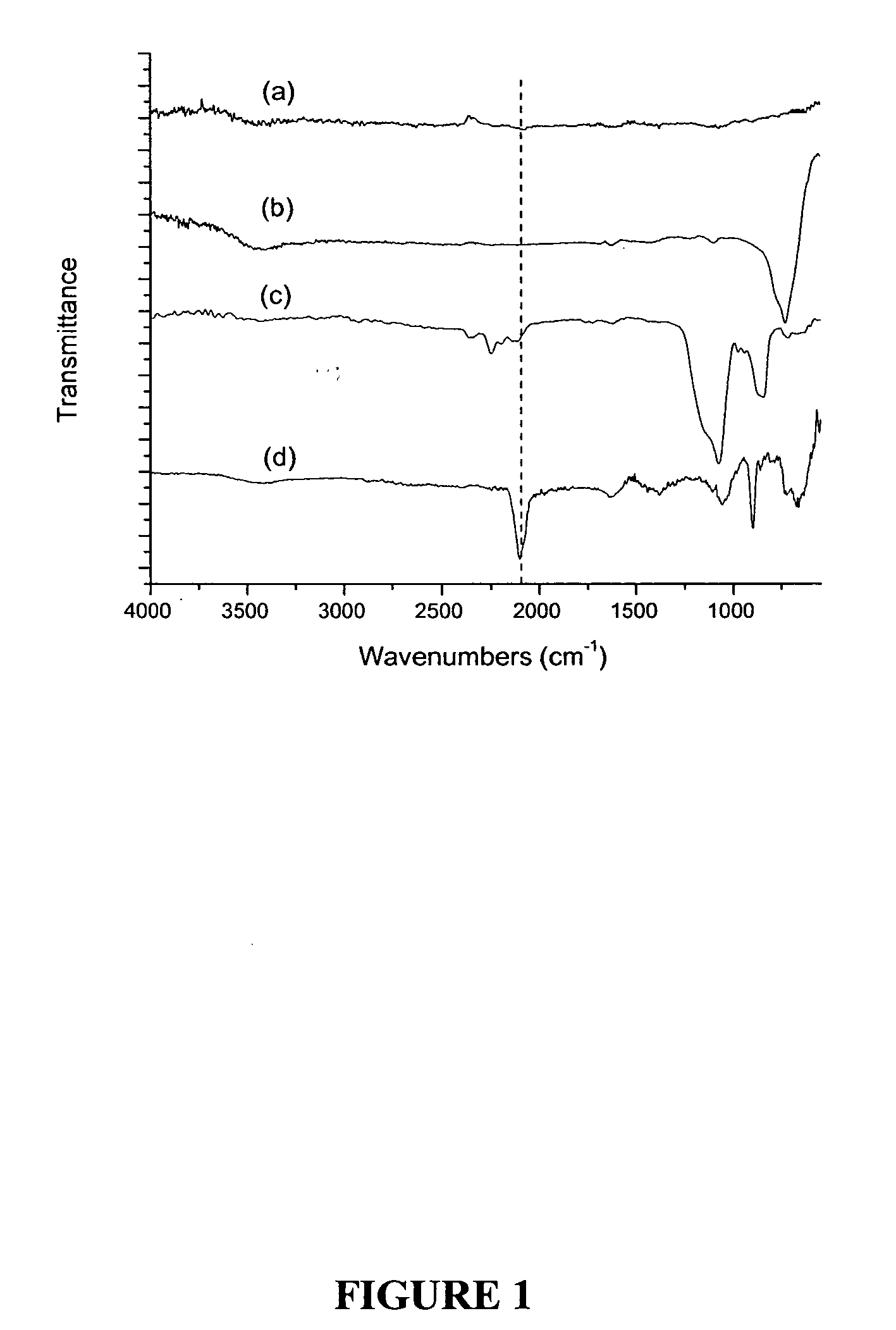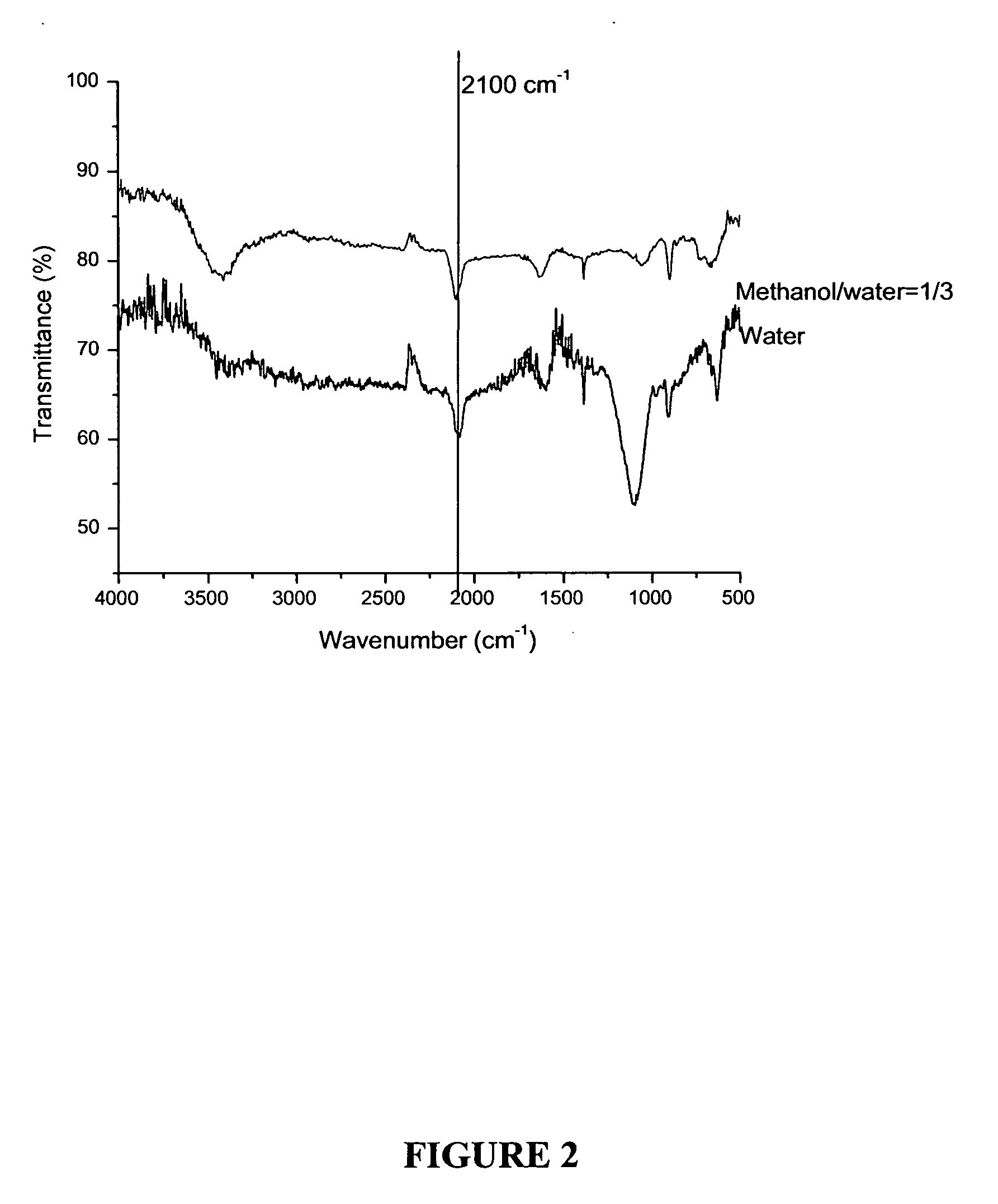Production of photoluminescent silicon nanoparticles having surfaces that are essentially free of residual oxygen
a technology of photoluminescent silicon nanoparticles and surface oxygen, which is applied in the direction of discharge tube luminescnet screens, polycrystalline material growth, transportation and packaging, etc., can solve the problems of lack of stability of the pl properties and surface state of the particles, the further investigation and application of free silicon nanoparticles, and the difficulty in producing macroscopic quantities of high-quality particles as stable colloidal dispersions. , to achieve the effect of low toxicity
- Summary
- Abstract
- Description
- Claims
- Application Information
AI Technical Summary
Benefits of technology
Problems solved by technology
Method used
Image
Examples
example 1
Efficient Surface Grafting of Luminescent Silicon Quantum Dots by Photoinitiated Hydrosilylation
[0075] Examples 1-9 relate to a method for efficient (high-coverage) grafting of organic molecules onto photoluminescent silicon nanoparticles (see Hua et al., Langmuir 21(13):6054-6062 (2005), which is hereby incorporated by reference in its entirety). High coverage grafting was enabled by use of a modified etching process that produces a hydrogen-terminated surface on the nanoparticles with very little residual oxygen and by carefully excluding oxygen during the grafting process. It had not previously been possible to produce such a clean H-terminated surface on free silicon nanoparticles or, subsequently, to produce grafted particles without significant surface oxygen. This allowed for the (1) preparation of air-stable green-emitting silicon nanoparticles; (2) preparation of stable dispersions of grafted silicon nanoparticles in a variety of organic solvents from which particles can r...
example 2
Materials Used for the Experimental Procedures Described in Examples 3 to 9
[0077] Silane (SiH4), (electronic grade, Scott Gases), 1-pentene (Acros, 95 wt %), 1-hexene (Acros, 97 wt %), 1-octene (Acros, 99+ wt %), 1-dodecene (Acros, 94 wt %), 1-octadecene (Acros, tech, 90 wt %), 5-hexen-1-ol (Aldrich, 99 wt %), 10-undecen-1-ol (Aldrich, 99 wt %), ethyl undecylenate (Aldrich, 97 wt %), styrene (Aldrich, 99 wt %, 15 ppm tert-4-tert-butylcatechol), vinyl acetate (Alfa Aesar, 99 wt %, stabilized with hydroquinone), triethylamine (Aldrich, 99.5 wt %), trifluoroacetic acid (Aldrich, 99 wt %), were used as received or were degassed by a series of freeze-thaw cycles as described herein. Silicon nanoparticles were prepared by silane (SiH4) dissociation through heating with a CO2 laser beam (Coherent, Model 42, 60 Watts) in an aerosol reactor, as described in detail by Li et al., Langmuir 19:8490 (2003), which is hereby incorporated by reference in its entirety. The resulting crystalline part...
example 3
Etching Procedure
[0078] The particles were etched with a mixture of HF (48 wt %) and HNO3 (69 wt %) (10 / 1, v / v). 20 mg of silicon nanoparticles was dispersed via sonication into 2 to 6 ml of methanol. 11 ml of acid mixture was added to the resulting dispersion. The particle sizes decreased and the particle surfaces were passivated during this etching process. As a result, the particles exhibited bright, visible photoluminescence. The color of the photoluminescence changed from red to yellow to green as the etching proceeded. The etching rate decreased with increasing amount of methanol used to disperse the particles initially. When the desired emission color was reached, the etching was slowed by adding about 10 ml of methanol or a methanol / water mixture (1 / 3, v / v). The particles were collected on a polyvinylidene fluoride (PVDF) membrane filter (pore size 100 nm) and washed with a large amount of the methanol / water mixture to remove any adsorbed acid mixture. Finally, the particle...
PUM
 Login to View More
Login to View More Abstract
Description
Claims
Application Information
 Login to View More
Login to View More - R&D
- Intellectual Property
- Life Sciences
- Materials
- Tech Scout
- Unparalleled Data Quality
- Higher Quality Content
- 60% Fewer Hallucinations
Browse by: Latest US Patents, China's latest patents, Technical Efficacy Thesaurus, Application Domain, Technology Topic, Popular Technical Reports.
© 2025 PatSnap. All rights reserved.Legal|Privacy policy|Modern Slavery Act Transparency Statement|Sitemap|About US| Contact US: help@patsnap.com



